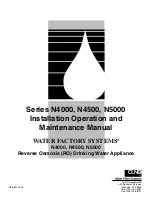
ALL RIGHTS RESERVED
3.4. ASSEMBLING THE RACK
3.4.1.
STEEL RACK TO WELD
(fig.7)
1) Fit the three threaded pawls on the rack element,
positioning them at the bottom of the slot. In this way, the
slot play will enable any future adjustments to be made.
2) Manually take the leaf to its closing position.
3) Lay the first section of rack level on the pinion and weld
the threaded pawl on the gate.
4) Move the gate manually, checking if the rack is resting on
the pinion, and weld the second and third pawl.
5) Position another rack element end to end with
the previous one, using a section of rack to
synchronise the teeth of the two elements.
6) Move the gate manually and weld the three threaded
pawls, thus proceeding until the gate is fully covered.
NOTES ON RACK INSTALLATION
• Make sure that, during the gate travel, all the rack
elements do not exit the pinion.
• In no case weld the rack elements neither to the spacers
nor to each other (only for steel rack).
• When the rack has been installed, to ensure it meshes
correctly with the pinion, it is advisable to lower the
gearmotor position by about 1.5 mm.
• Manually check if the gate correctly reaches the
mechanical limit stops maintaining the pinion and rack
coupled and make sure there is no friction during gate
travel.
• Do not use grease or other lubricants between rack and
pinion.
Fig. 7
3.4.2.
STEEL RACK TO SCREW
(fig. 8)
1) Manually take the leaf into its closing position.
2) Lay the first section of rack level on the pinion and place
the spacer between the rack and the gate, positioning it at
the bottom of the slot.
3) Mark the drilling point on the gate. Drill a Ø 6,5 mm hole
and thread with an M8 male tap. Screw the bolt.
4) Move the gate manually, checking if the rack is resting on
the pinion, and repeat the operations at point 3.
5) Position another rack element end to end with the
previous one, using a section of rack to synchronise the
teeth of the two elements.
6) Move the gate manually and carry out the securing
operations as for the first element, thus proceeding until the
gate is fully covered.
Fig. 8
3.4.3.
NYLON RACK TO SCREW
(fig. 9)
1) Manually take the leaf to its closing position.
2) Lay the first section of rack level on the pinion.
3) Mark the drilling point on the gate. Drill a Ø 4 mm hole
and thread with screw 6x20 mm with relative plate
reinforcement.
4) Move the gate manually, to check if the rack is resting on
the pinion, and repeat the operations at point 2.
5) Position another rack element end to end with the
previous one, using a section of rack to synchronize the
teeth of the two elements.
6) Move the gate manually and carry out the securing
operations as for the first element, thus proceeding until the
gate is fully covered.
4.
START UP
4.1. CONTROL BOARD CONNECTION
ATTENTION:
Before attempting any work on the board
(connections, programming, maintenance), always
turn off the power supply.
4.2. ADJUSTING THE TORQUE TRANSMISSION
(only for MSC 2000)
To adjust the torque transmission, act on the screw placed on the
engine (Fig. 10):
- Rotate the screw clockwise to increase the torque transmission.
- Rotate the screw anticlockwise to decrease the torque
transmission.
CAUTION: THE MOTOR IS PROVIDED WITH THE CLUTCH
REGULATED AT MAX.THE SCREW SHOULD BE ROTATED
ANTICLOCKWISE, UP TO ACHIEVE THE OPTIMAL
ADJUSTMENT.
Fig. 9
Fig. 10



























